BDRC has always been a collaborative enterprise; indeed, our work digitizing and disseminating Buddhist literature around the world would not be possible without our partners. From the very beginning, our founder Gene Smith always worked together with lamas, publishers, and scholars to preserve, reprint, digitize, catalogue, and distribute the Tibetan literary heritage. To maintain our core commitment to collaboration, BDRC's new web platform was built especially to enable high-tech data sharing.
While we have partnerships around the world, today we want to highlight and celebrate our partnerships with major institutions in India, which is in many ways the birthplace of TBRC/BDRC. Recently we have released online hundreds of volumes of significant works provided to BDRC by our long-time partners Dr. Lokesh Chandra and the International Institute of Indian Culture, the Central Institute of Higher Tibetan Studies, and the Library of Tibetan Works and Archives.
Lokesh Chandra and the International Institute of Indian Culture
Our longest running partnership has been with Dr. Lokesh Chandra (seen below with our Executive Director Dr. Jann Ronis) and the International Institute of Indian Culture in New Delhi. Dr. Lokesh Chandra and his father Dr. Raghu Vira Chandra were trailblazers in the field of Buddhist Studies. Both prolific editors and writers, among their many enduring contributions to Buddhist Studies is the Śata-piṭaka Series, a vehicle for the publication of countless volumes of Buddhist classics in Sanskrit, Tibetan, and Mongolian as well as their immense Tibetan-Sanskrit Dictionary.
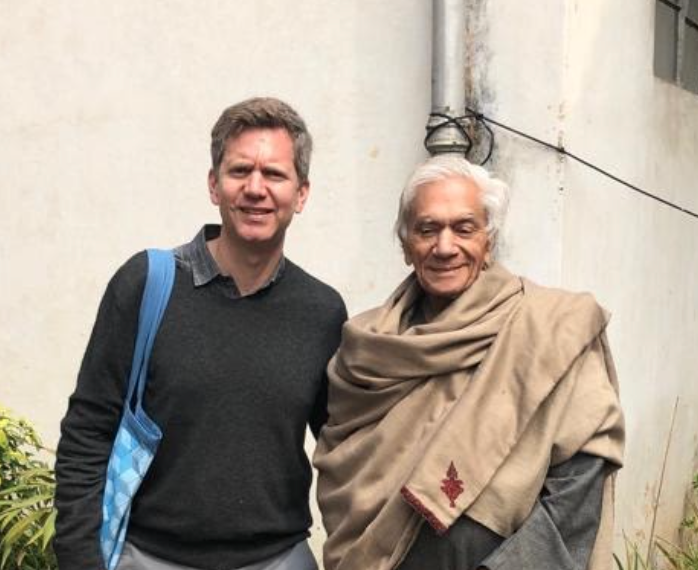 In 1955, Dr. Raghu Vira Chandra, scholar, politician and a pioneer of cultural relations between India and the Inner and East Asian Buddhist nations, traveled to the Mogao Caves in Dunhuang to see for himself this monument to Indian religion and art. It is said that he brought back to India 300 wooden crates of Buddhist manuscripts and objects collected during the trip; and this was just the beginning of the Chandra family's relationship with cultural institutions in China, Japan, Mongolia, and elsewhere. Dr. Lokesh Chandra generously allowed BDRC to scan all the contents of his irreplaceable library and all of these Tibetan works are now online and available for your access. A few of highlights are the Tangut Tripitaka from the Śata-piṭaka Series, the Beijing Kangyur, and the Four Medical Tantras published by Chakpori in Lhasa in 1888. The full list of contents from the Chandra library is viewable here, and our catalogue can be found here. Please note that our working outlines for the Chandra collection are not fully finalized; if you notice any issues, we would love to hear from you so we can fix them.
In 1955, Dr. Raghu Vira Chandra, scholar, politician and a pioneer of cultural relations between India and the Inner and East Asian Buddhist nations, traveled to the Mogao Caves in Dunhuang to see for himself this monument to Indian religion and art. It is said that he brought back to India 300 wooden crates of Buddhist manuscripts and objects collected during the trip; and this was just the beginning of the Chandra family's relationship with cultural institutions in China, Japan, Mongolia, and elsewhere. Dr. Lokesh Chandra generously allowed BDRC to scan all the contents of his irreplaceable library and all of these Tibetan works are now online and available for your access. A few of highlights are the Tangut Tripitaka from the Śata-piṭaka Series, the Beijing Kangyur, and the Four Medical Tantras published by Chakpori in Lhasa in 1888. The full list of contents from the Chandra library is viewable here, and our catalogue can be found here. Please note that our working outlines for the Chandra collection are not fully finalized; if you notice any issues, we would love to hear from you so we can fix them.
It was Mangaram Kashyap who initiated the Lokesh Chandra-BDRC partnership. Mangaram was Gene Smith's major domo in India for over 20 years and played a crucial role in the herculean preservation work that Gene conducted in India in the 60s, 70s, and 80s. In the late 1990s when Gene was contemplating scanning his personal library of nearly ten thousand volumes, it was Mangaram who devised a viable workflow.
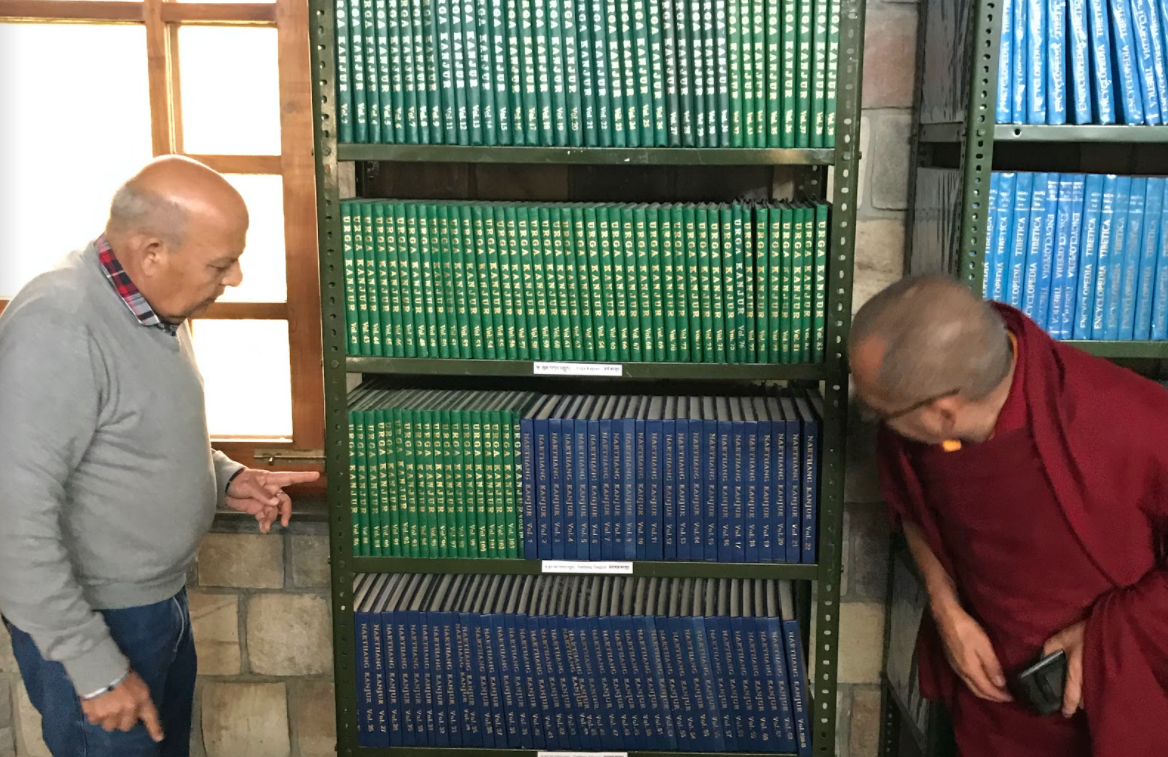 Mangaram in 2019 inspecting Kangyur collections published by Lokesh Chandra. Mangaram organized all of the fabled dinner parties for scholars and diplomats held at Gene's home in New Delhi and also made possible the many visits by lamas and their entourages. When Gene contemplated scanning his personal library, Mangaram tested the equipment and worked out the workflow.
Mangaram in 2019 inspecting Kangyur collections published by Lokesh Chandra. Mangaram organized all of the fabled dinner parties for scholars and diplomats held at Gene's home in New Delhi and also made possible the many visits by lamas and their entourages. When Gene contemplated scanning his personal library, Mangaram tested the equipment and worked out the workflow.For years, he managed the team that scanned the vast majority of the works that went into the TBRC archive. Managaram continued to further Gene's legacy in recent years, including the scanning of the Chandra library. All of the TBRC/BDRC old guard know that Mangaram was Gene's right hand man for over 40 years; this organization would not exist without the humble founding figure of Mangaram Kashyap.
Central Institute of Higher Tibetan Studies
Established in Sarnath in 1967 after a dialogue between Prime Minister Jawaharlal Nehru and the Fourteenth Dalai Lama, CIHTS was founded as a specialized institute of higher education in the field of Tibetan Buddhist Studies. Intended as a special project of the Indian Ministry of Culture to restore and retranslate lost Sanskrit texts back from the Tibetan and to preserve Tibetan culture and tradition, the CIHTS has since educated an entire generation of Tibetan and Himalayan scholars and become a renowned institute for Buddhist Studies. The partnership between BDRC and CIHTS was formalized in 2018 under Vice-Chancellor Professor Geshe Ngawang Samten. The two institutions agreed to share all digital texts between the two libraries, BDRC's and CIHTS's illustrious Shantarakshita Library. Furthermore, the staff of Shantarakshita Library's Tibetan and Multimedia sections have been kindly filling in the gaps in our library by providing us scans of pages or whole texts when we have a particular need.
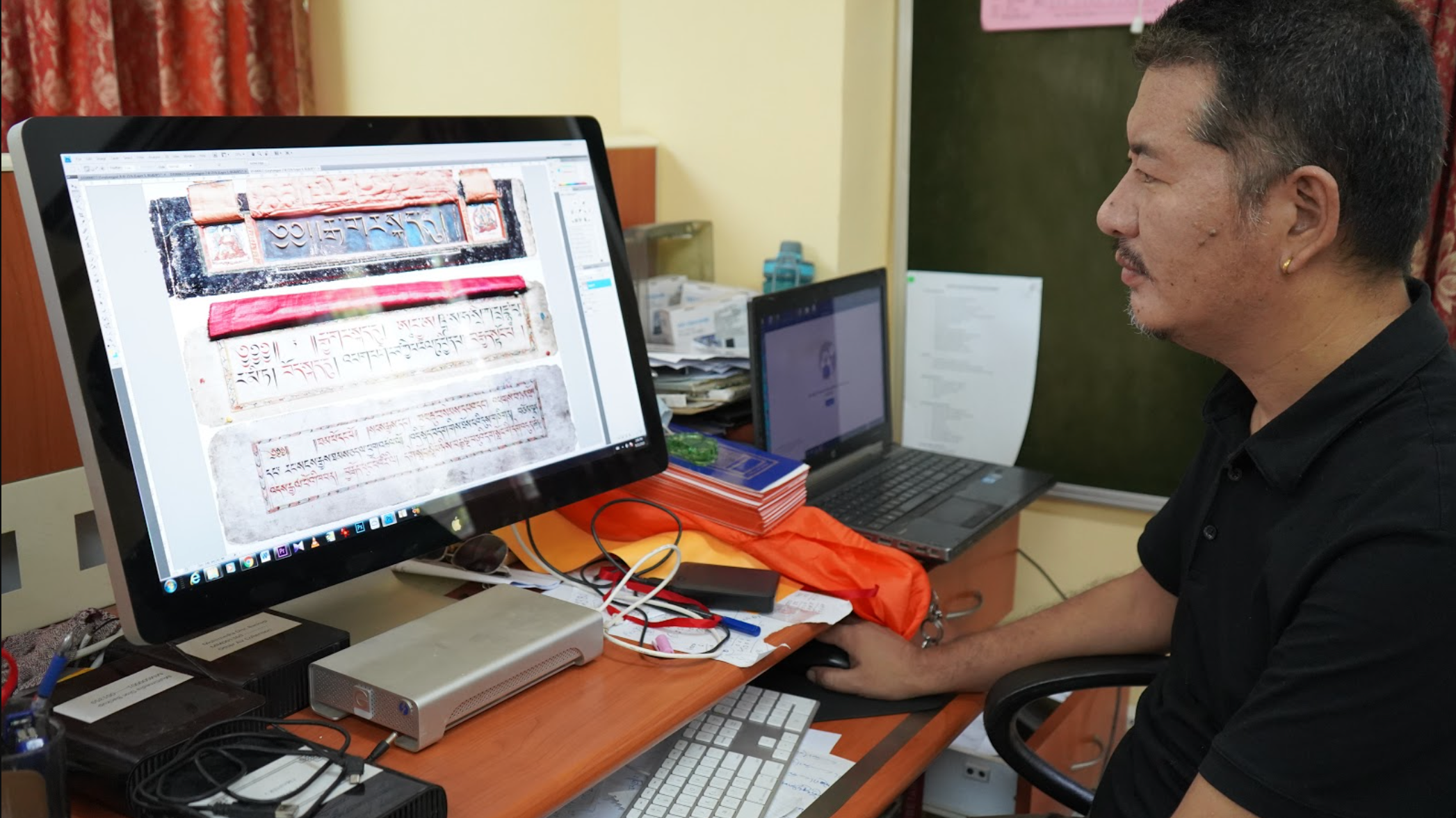 Tenzin Dhonyoe, Head of Multimedia Section at CIHTS.
Tenzin Dhonyoe, Head of Multimedia Section at CIHTS.Noteworthy from their collection are the Gondhola Proto Kangyur, an early 14th century manuscript collection from Gondhola village in Lahaul in northern India comprising 397 texts in 36 volumes. Handwritten in Uchen script, it seems at least parts of this collection were written for the local rulers of Gondhola, to whose descendants the Kangyur belongs. There's also the Prajñāpāramitā in eight thousand verses, a mainstay of the Tibetan monastic curriculum, in the Sanskrit version, published by CIHTS.
The Library of Tibetan Works and Archives
The Library of Tibetan Works and Archives founded in 1970 is one of the most important institutes in the Tibetan cultural world. Based in Dharamsala, the headquarters of the Central Tibetan Administration, its founding director was Gyatsho Tshering, a Sikkimmese who chose to dedicate his life to rebuilding the Tibetan exile community in India. LTWA is now not just a library, an archive or an educational institute, but also an outstanding publisher regularly producing masterworks of classical and contemporary Tibetan literature. Although Gene Smith had a long-standing relationship with LTWA dating back to his early years in India, it was in 2007/8 when Gene met with Director Geshe Lhakdor that a mutual data-sharing partnership between the two institutions was initiated. In 2019, our Senior Librarian Lobsang Shastri, formerly of the LTWA, and Geshe Lhakdor exchanged hard drives of the archives of the two libraries, both committed to the preservation and distribution of Tibetan literature.
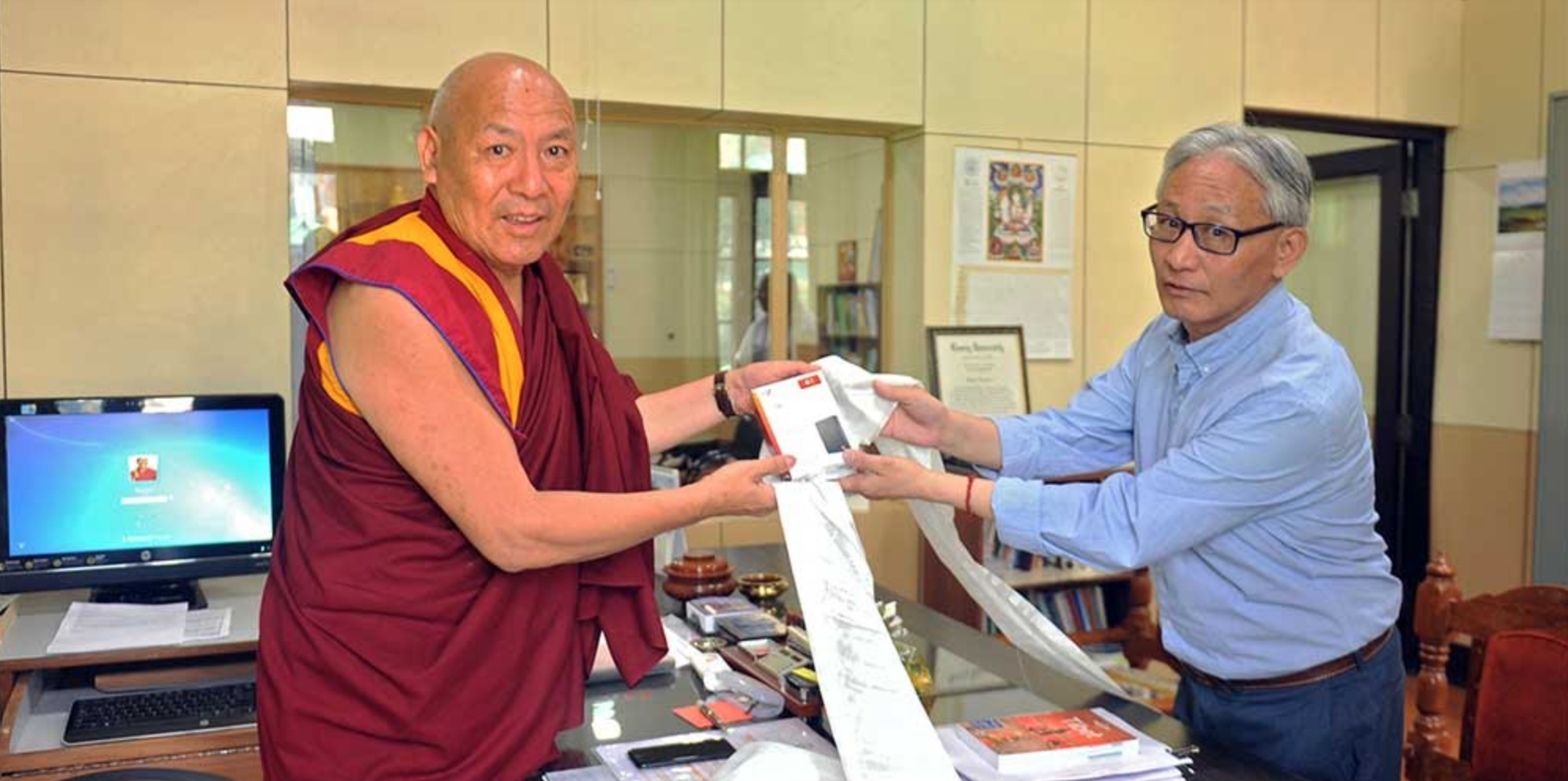 Senior Librarian Lobsang Shastri presenting a BDRC hard drive to long-time LTWA Director Geshe Lhakdor, June 2019.
Senior Librarian Lobsang Shastri presenting a BDRC hard drive to long-time LTWA Director Geshe Lhakdor, June 2019.Some of the most significant acquisitions from the LTWA collection include the Phugdrak Kangyur from Western Tibet, an extremely rare Kangyur written sometime between 1696 and 1706 at Phugdrak Monastery. The Narthang Tengyur from the mid-eighteenth century with 223 volumes is also a very important collection, one of five extant Tengyur editions in the world.
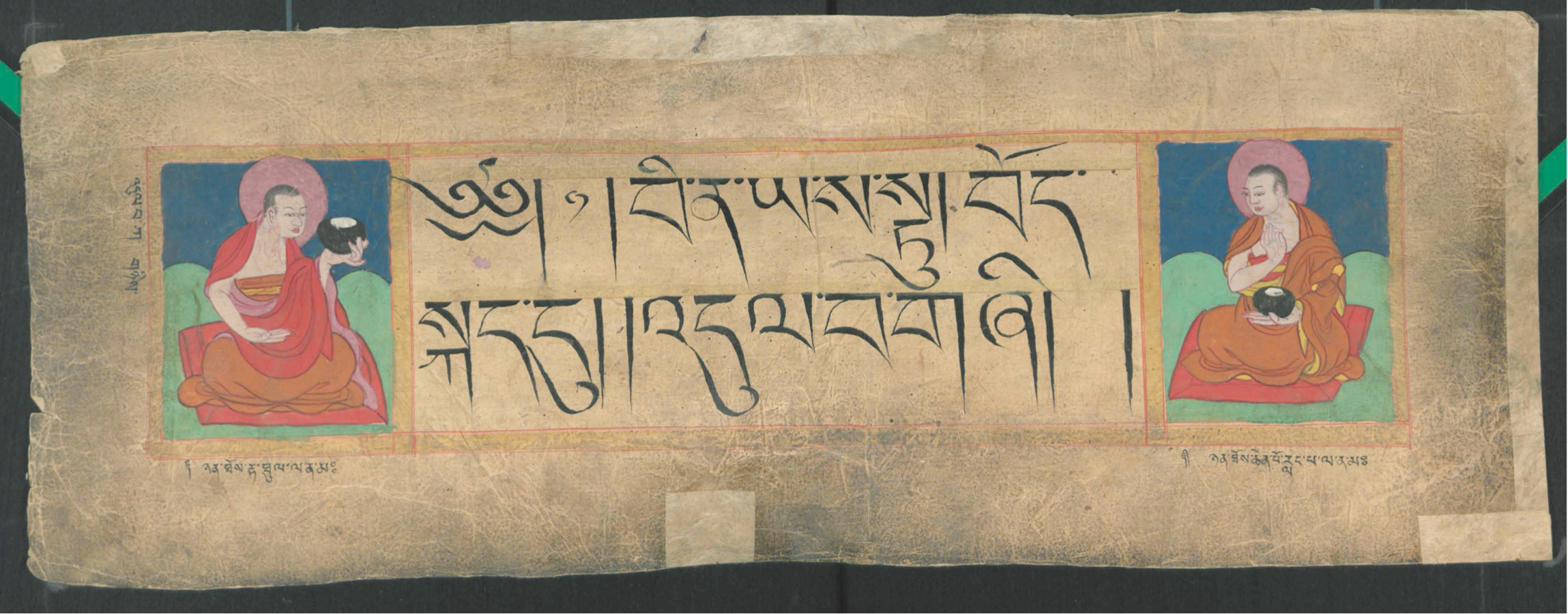 Containing 120 volumes, all with an appearance of total scribal uniformity although written by different scribes, the Phugdrak Kangyur has 25 unique titles that do not appear in any other Kangyur collection. The LTWA's high resolution images of the Phugdrak Kangyur are made available by BDRC on an as-needed basis. BDRC Resource ID: W1KG13607.
Containing 120 volumes, all with an appearance of total scribal uniformity although written by different scribes, the Phugdrak Kangyur has 25 unique titles that do not appear in any other Kangyur collection. The LTWA's high resolution images of the Phugdrak Kangyur are made available by BDRC on an as-needed basis. BDRC Resource ID: W1KG13607.BDRC is indebted to our Indian partners who have made our work possible.





Sorry, the comment form is closed at this time.